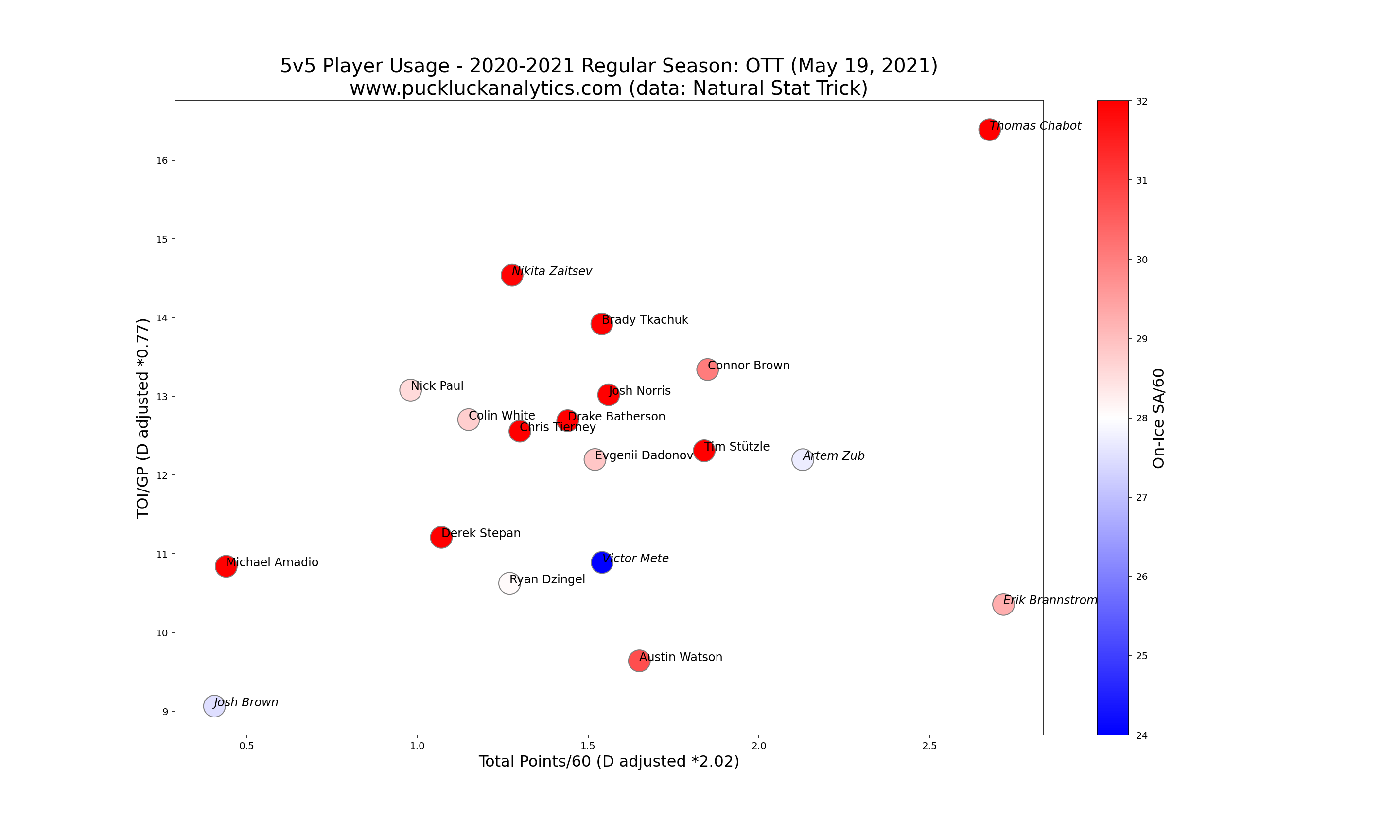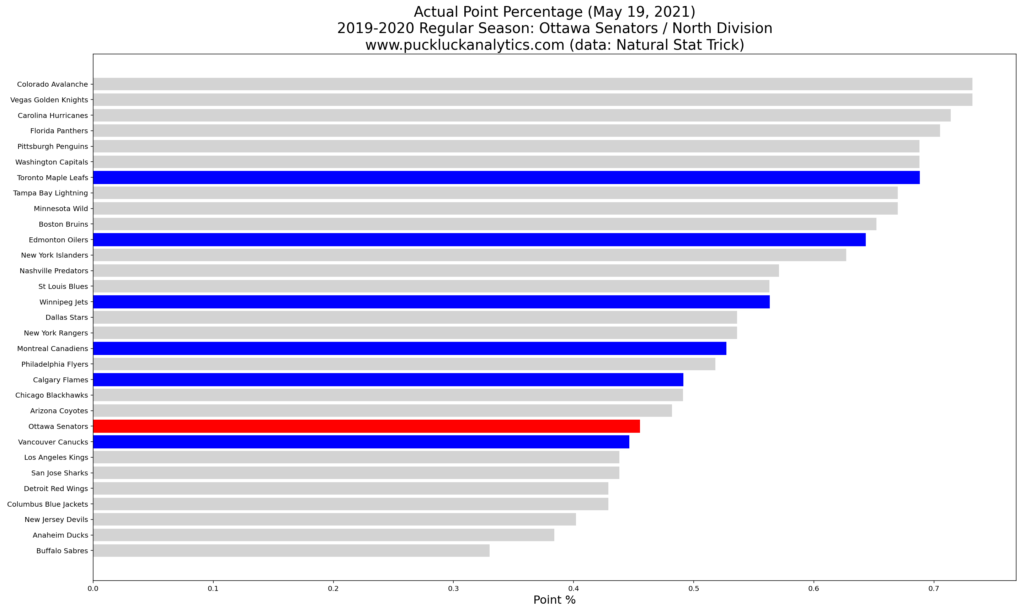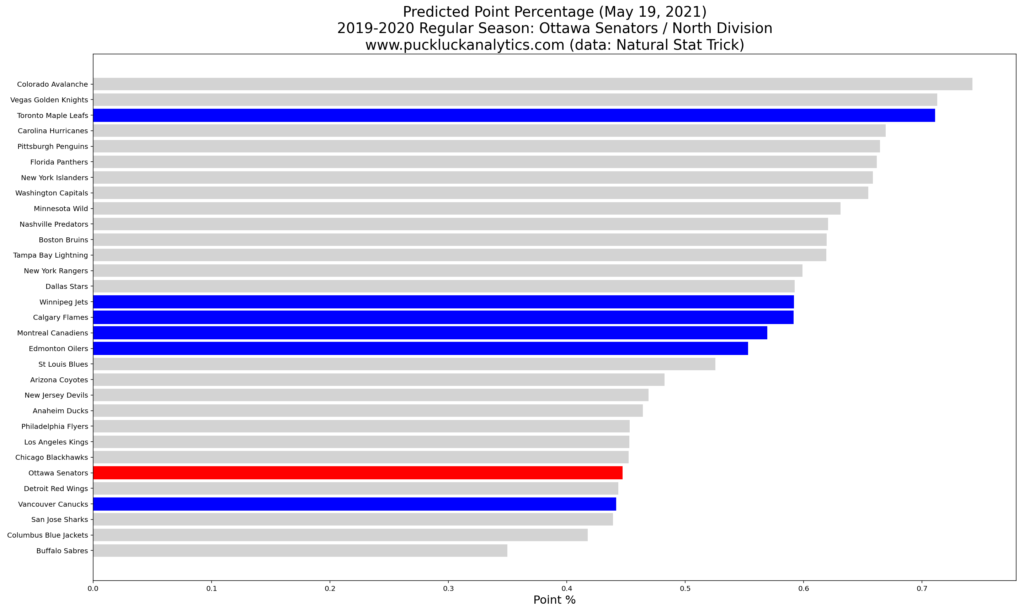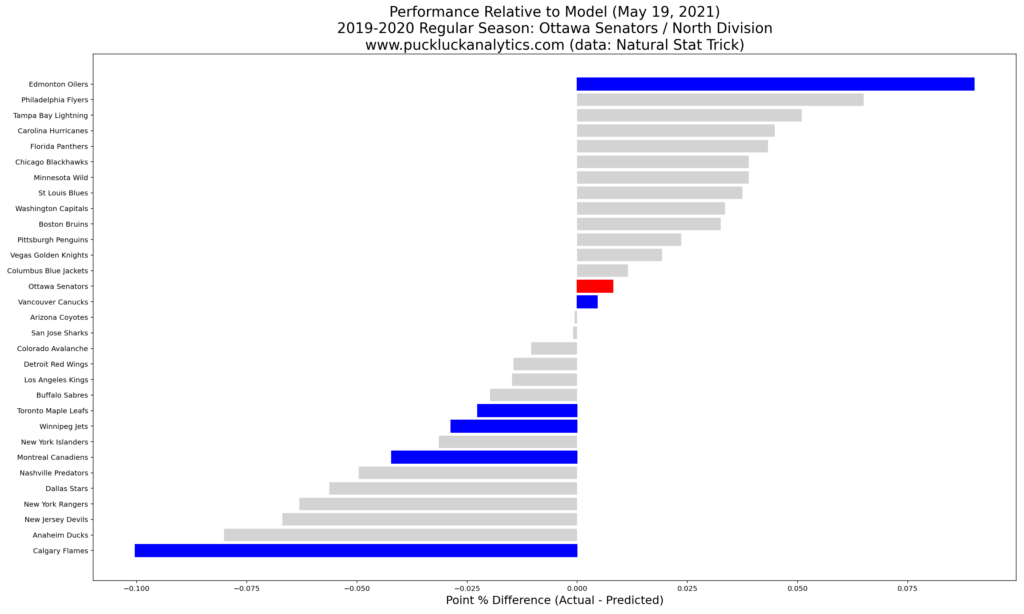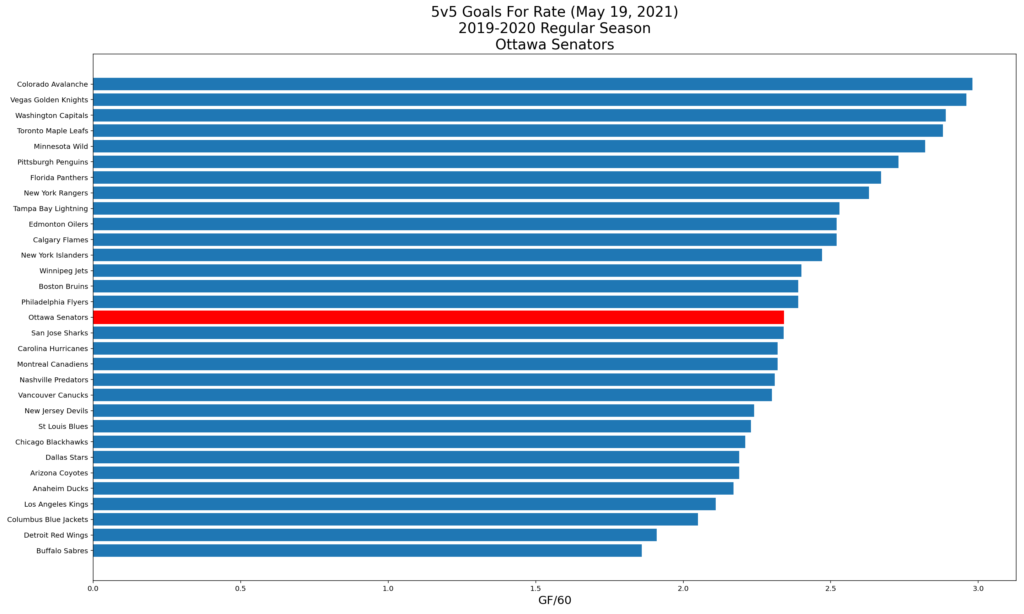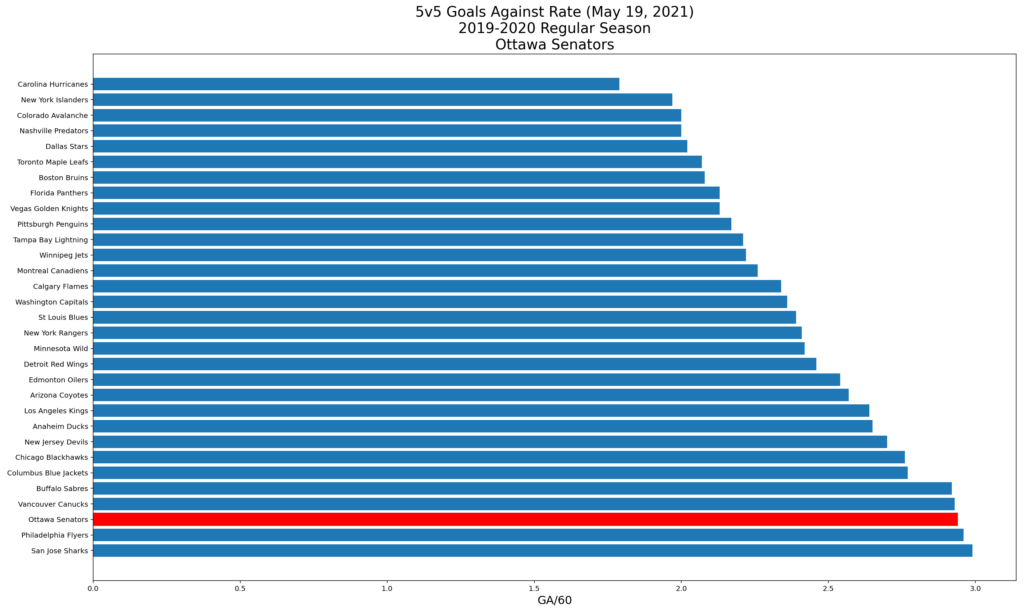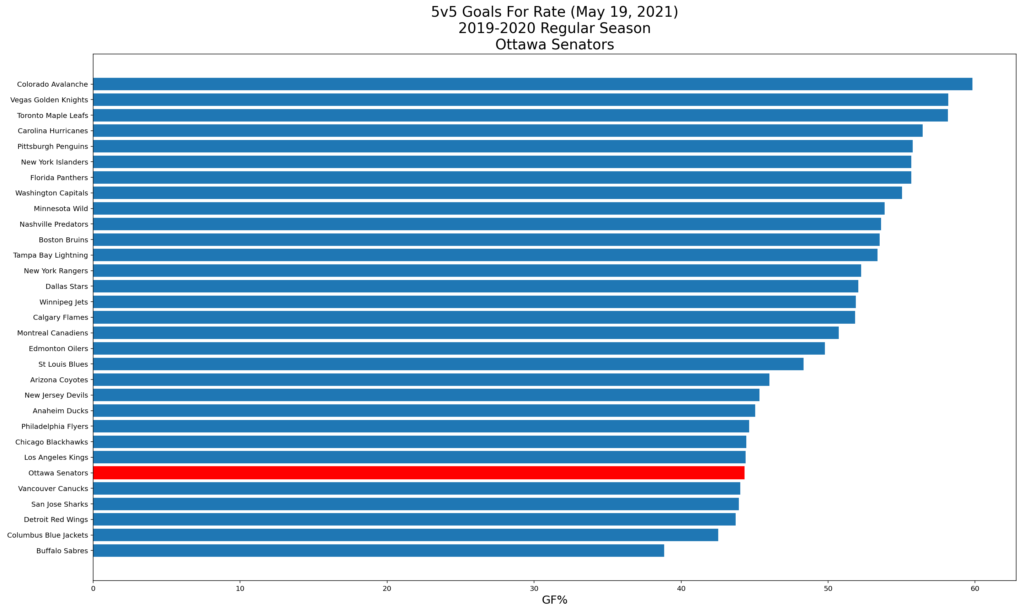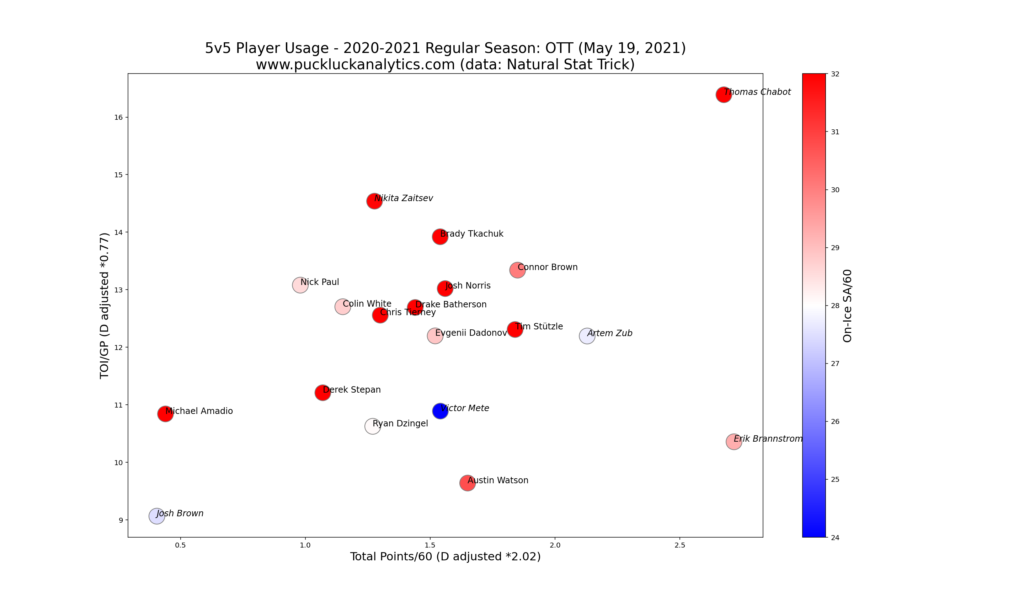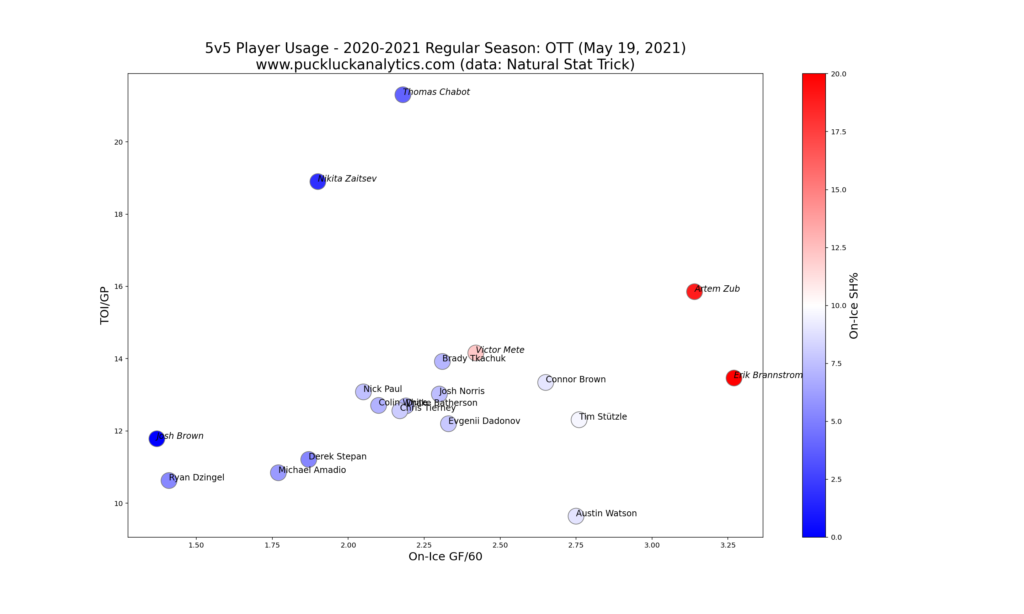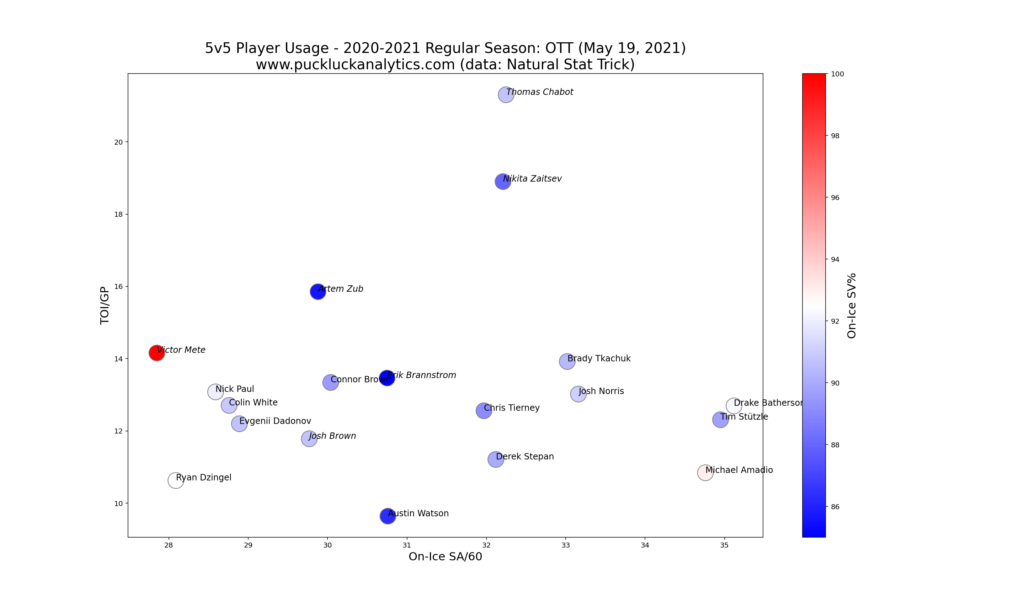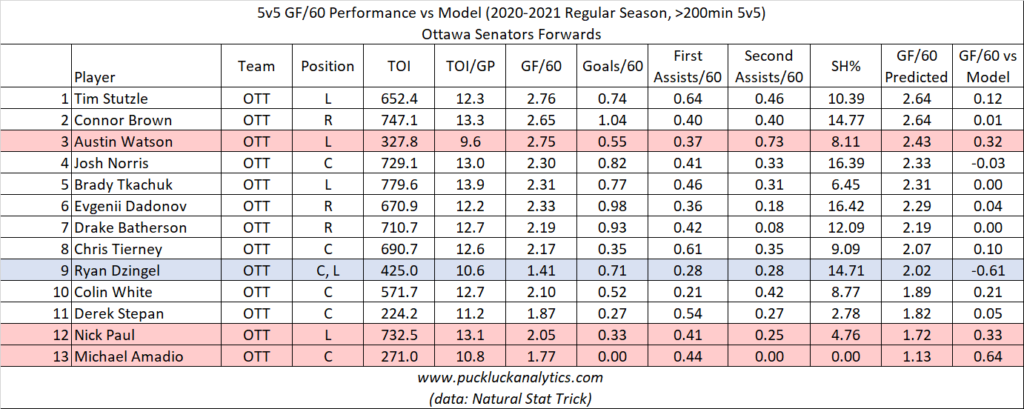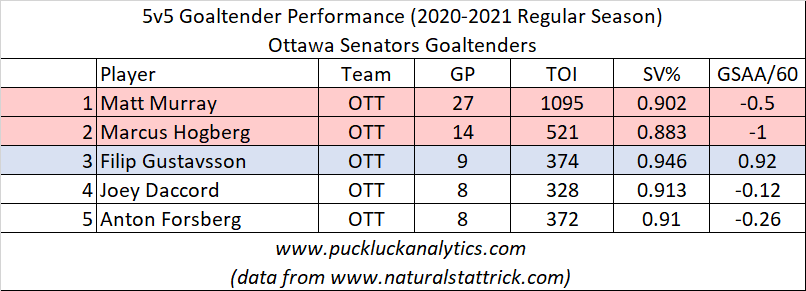The Ottawa Senators were widely expected to occupy the North Division cellar heading into the 2020-2021 season. After a terrible start to the season, the Senators turned it on in the second half and finished ahead of the Vancouver Canucks. In the Senators season review, we’ll look at whether the breakout performances from a number of young players can sustain their second half momentum into next season. If you haven’t already read it, I encourage you to give this post a read that has some additional detail on what I look for in the plots we’ll look at.
Overall Performance
With a second half surge that saw the Senators give a number of stronger teams in the North a challenge in the second half of the season, the Sens finished in 6th in the division. Is this a sign of things to come? Looking at our points predictor model with comparison to actual results gives us the first indication.
The model results are quite close to the Senators’ actual point percentage and the model also puts them in 6th place. The model uses 5v5 goal rates from the complete season as input, so the Sens are likely in a good position to repeat their overall season performance with the current roster. We shouldn’t focus too heavily on the poor results early season or the strong results later in the season.
Let’s take a look at the 5v5 goal rates feeding the model.
We see the Senators offense was fairly respectable this season, sitting in the middle of the pack when compared to the entire league. Defense was another story, however, and their inability to keep the puck out of their own net will be a problem they need to address in the offseason. With approximately a 50/50 split between the impact from goaltenders and combined impact from skaters, we’ll delve deeper into where the Sens should focus their efforts as we look at player performance.
Player Performance
We start our review of individual player performance with a 5v5 player usage chart. Defensemen’s stats have been factored on this chart for direct comparison with forwards and the resulting plot gives us a visual depth chart on the diagonal from top right to bottom left.
Thomas Chabot jumps out as head and shoulders above the rest of the Sens. He is clearly the best player on the roster. The rest of the team is grouped fairly closely together in the center of the chart, which suggests the Sens preferred to roll four lines. To evolve into a contending team, the Sens will need some of their forwards to grow into roles as higher impact players to close the gap with Chabot.
Plotting 5v5 on-ice GF/60 versus TOI/GP gives us a visual depiction of the relative offensive impact of each player. Players further to the top right had larger contributions to the overall team GF/60.
We see Tim Stuzle and Connor Brown with the highest GF/60 among forwards. These two players are prime candidates to earn a bit more ice time and step into the scoring roles at the top of the lineup. Picking up Victor Mete off waivers from the Canadiens looks like an astute move by the Sens to improve their defense core. His offensive impact wasn’t off the charts but he does look like a quality NHL defenseman and he fit in nicely in Ottawa.
We get a similar visual for skater GA/60 contributions by looking at SA/60 versus TOI/GP. This time, we are looking for players further down and left for more positive contributions.
Here we see why Stuztle’s ice time was more limited than his offensive impact would suggest. Stuzle and Drake Batherson both struggled defensively this season. While their offensive contributions were good, they need to develop their defensive games to become higher impact players. Here, we see Mete really stand out among defensemen with the best defensive impact on the team.
Looking at the results from our on-ice GF/60 model, we get some insight into which players carried their line mates offensively. We are generally interested in variances greater than about 0.25 and we need to watch for shooting percentage effects since we use goals as input to the model. Let’s start with the forwards.
For the most part, the Sens forwards actual on-ice GF/60 numbers are very close to our model prediction. Ryan Dzingel is the only forward who stands out with a significant negative variance, which indicates he carried his line mates offensively. Looking back at our initial usage chart, it looks like he was under-utilized to a small degree and this finding suggests that the Sens could get more out of him in a slightly larger role. On the other hand, Austin Watson has a significant variance the other way and the Sens may want to reduce his role slightly.
Moving on to defensemen, the large variance from the model we see for Chabot gives us more evidence that he is the best player on the team. Nikita Zaitsev and Josh Brown also had large enough variances below the model that they look like they had positive impacts on their line mates. On the other hand Eric Brannstrom and Artem Zub were the opposite and the Sens should look at reducing their roles to get the highest impact out of their defense group.
Goaltending was an issue for the Senators this year. Matt Murray struggled mightily early in the season. While his numbers improved with some better play later in the year, the Sens had to be disappointed with his overall numbers. Marcus Hogberg wasn’t able to step up with Murray struggling, also posting some poor numbers on the season. Filip Gustavsson was a bright spot, putting up solid numbers but with only 9 GP he wasn’t able to move the dial for the Sens goaltending as a whole.
Looking Ahead
The Senators have about $53M committed to next season’s cap as they head into the offseason. While they have a few key RFAs to re-sign, they should have enough room to make some additional moves to improve the team.
Key RFAs:
Brady Tkachuk and Drake Batherson are both at the end of their entry level contracts. With both players showing positive impacts on the team, the Sens will surely re-sign both. While both have shown reasonably good offensive impact, we saw these two players as two of the Sens’s skaters with the worst defensive impact. The Senators should be careful about signing these players to big, long term deals at this point.
Victor Mete is also headed for restricted free agency. He was under-utilized in Montreal and had a positive impact in Ottawa after the Senators claimed him off waivers.
Key UFAs:
Artem Anisimov and Ryan Dzingel are unrestricted free agents. While neither is an elite talent, there will be a couple of holes in the lineup that the Sens need to fill should they leave town. We saw that Dzingel carried his line mates in our review, making him the obvious choice should the Sens want to re-sign one of these players.
Key Players Under Contract:
Matt Murray was brought in during free agency last year to provide the Sens with a #1 goaltender. His performance this season was underwhelming. The Senators need him to be better next season.
The continued development of the Senators under-23 forwards is also key to their success for the next few years. In addition to RFAs Tkachuk and Batherson, Stuzle, Josh Norris, Shane Pinto, and Alex Formenton are all under 23 and could form a strong core group of forwards in a few years.
Tough Questions:
Can Matt Murray turn it around? In addition to his underwhelming numbers this season, the former Pen had a rough final season in Pittsburgh before signing with Ottawa last summer. With 3 years remaining at a cap hit of $6.25M on his deal and only age 26, the Senators will surely give him a chance for redemption next season. If he doesn’t bounce back, what is the Sens backup plan?
Offseason Priority:
The Senators’ goaltending held them back this season and it needs to improve. While it’s likely that Matt Murray will enter next season with another chance to be #1 in Ottawa, the Sens need to ensure they have a capable backup after Murray’s results the past two seasons. Filip Gustavsson looked like the best bet within the organization this year, but we have only 9 games worth of NHL data to go by. If the Sens don’t feel he is ready for primetime, they need to acquire a capable backup.
The Senators could also use a defensively responsible top six forward to play with their talented young forwards. We saw that there are still some growing pains on the defensive side of the puck for some of the Sens’ young guns. The addition of such a forward could help the Sens’ defensive numbers while their young stars continue to develop their defensive games.
Check out my other season reviews that are already up, such as the Chicago Blackhawks and the Vancouver Canucks, and subscribe to catch the rest of my season reviews as they come out.
data: Natural Stat Trick
cap data: CapFriendly
